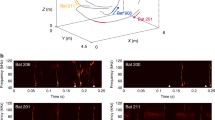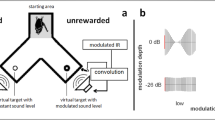Abstract
In this modeling study we wanted to find out why bats of the family Vespertilionidae (and probably also members of other families of bats) use pulses with a certain bandwidth and duration. Previous studies have only speculated on the function of bandwidth and pulse duration in bat echolocation or addressed this problem by assuming that bats optimize echolocation parameters to achieve very fine acuities in receiving single echoes. Here, we take a different approach by assuming that bats in nature rarely receive single echoes from each pulse emission, but rather many highly overlapping echoes. Some echolocation tasks require individual echoes to be separated to reconstruct reflection points in space. We used an established hearing model to investigate how the parameters bandwidth and pulse duration influence the separation of overlapping echoes. Our findings corroborate the following previously unknown or unsubstantiated facts:
-
1.
Broadening the bandwidth improves the bat’s lower resolution limit.
-
2.
Increasing the sweep rate (defined by bandwidth and pulse duration) improves acuity of each extracted echo.
-
3.
Decreasing the sweep rate improves the probability of frequency channels being activated.
Since facts 2 and 3 affect sweep rate in an opposing fashion, an optimum sweep rate will exist, depending on the quality of the returning echoes and the requirements of the bat to improve acuity. The existence of an optimal sweep rate explains why bats are likely to use certain combinations of bandwidth and pulse duration to obtain such sweep rates.
Similar content being viewed by others
References
Aertsen AMHJ, Johannesma PIM (1980) Spectro-temporal receptive fields of auditory neurons in the grassfrog. I Characterization of tonal and natural stimuli. Biol Cybernetics 38:223–234
Airapetianz ESH, Konstantinov AI (1974) Echolocation in nature. Nauka, Leningrad (English translation, Joint Publications Research Service, no. 63328, 1000 North Glebe Road, Arlington, VA 22201)
Beedholm K (2006) The transfer function of a target limits the detection threshold with signals of echolocating FM-bats. J Comp Physiol A 192:461–468
Beedholm K, Møhl B (1998) Bat sonar: an alternative interpretation of the 10-ns jitter result. J Comp Physiol A 182:259–266
de Boer E, de Jongh HR (1978) On cochlear encoding: potentialities and limitations of the reverse-correlation technique. J Acoust Soc Am 63:115–135
Denzinger A, Schnitzler HU (1994) Echo SPL influences the ranging performance of the big brown bat, Eptesicus fuscus. J Comp Physiol 175:563–571
Denzinger A, Kalko EKV, Jones G (2004) Ecological and evolutionary aspects of echolocation in bats. In: Thomas JA, Moss CF, Vater M (eds) Echolocation by bats and dolphins. University of Chicago Press, Chicago, pp 311–326
Fuzessery ZM (1994) Response selectivity for multiple dimensions of frequency sweeps in the pallid bat inferior colliculus. J Neurophysiol 72:1061–1079
Fuzessery ZM, Richardson MD, Coburn MS (2006) Neural mechanisms underlying selectivity for the rate and direction of FM sweeps in the inferior colliculus of the pallid bat. J Neurophysiol 96:1320–1336
Grunwald JE, Schörnich S, Wiegrebe L (2004) Classification of natural textures in echolocation. Proc Natl Acad Sci 101:5670–5674
Habersetzer J, Vogler B (1983) Discrimination of surface-structured targets by the echolocating bat, Myotis myotis, during flight. J Comp Physiol A 152:275–282
Hackbarth H (1986) Phase evaluation in hypothetical receivers simulating ranging in bats. Biol Cybern 54:281–287
Holderied MW, Jones G, von Helversen O (2006) Flight and echolocation behaviour of whiskered bats commuting along a hedgerow: range-dependent sonar signal design, Doppler tolerance and evidence for ‘acoustic focussing’. J Exp Biol 209:1816–1826
Johnson DJ (1980) The relationship between spike rate and synchrony in responses of auditory nerves to single tones. J Acoust Soc Am 68:1115–1122
Koppl C (1997) Phase locking to high frequencies in the auditory nerve and cochlear nucleus magnocellularis of the barn owl, Tyto alba. J Neurosci 17:3312–3321
Kössl M (1992) High frequency distortion products from the ears of two bat species, Megaderma lyra and Carollia perspicillata. Hear Res 60:156–164
Masters WM, Jacobs SC (1989) Target detection and range resolution by the big brown bat (Eptesicus fuscus) using normal and time-reversed model echoes. J Comp Physiol A 166:65–73
Masters WM, Raver KAS (1996) The degradation of distance discrimination in big brown bats (Eptesicus fuscus) caused by different interference signals. J Comp Physiol A 179:703–713
Masters WM, Raver KAS (2000) Range discrimination by big brown bats (Eptesicus fuscus) using altered model echoes: Implications for signal processing. J Acoust Soc Am 107:625–637
Matsuo I, Tani J, Yano M (2001) A model of echolocation of multiple targets in 3D space from a single emission. J Acoust Soc Am 110:607–624
Matsuo I, Kunugiyama K, Yano M (2004) An echolocation model for range discrimination of multiple closely spaced objects: Transformation of spectrogram into the reflected intensity distribution. J Acoust Soc Am 115:920–928
Matsuo I, Yano M (2004) An echolocation model for the restoration of an acoustic image from a single-emission echo. J Acoust Soc Am 116:3782–3788
Miller LA (1991) Arctiid moth clicks can degrade the accuracy of range difference discrimination in echolocating brown bats, Eptesicus fuscus. J Comp Physiol A 168:571–579
Mogdans J, Schnitzler HU, Ostwald J (1993) Discrimination of 2-wavefront echoes by the big brown bat, Eptesicus fuscus: behavioral experiments and receiver simulations. J Comp Physiol A 172:309–323
Moss CF, Schnitzler HU (1995) Behavioral studies of auditory information processing. In: Popper AN, Fay RR (eds) Hearing by bats. Springer, New York, pp 87–145
Müller R, Kuc R (2000) Foliage echoes: A probe into the ecological acoustics of bat echolocation. J Acoust Soc Am 108:836–845
Neretti N, Sanderson MI, Intrator N, Simmons JA (2003) Time-frequency model for echo-delay resolution in wideband biosonar. J Acoust Soc Am 113:2137–2145
Oxenham AJ, Moore BC (1994) Modeling the additivity of nonsimultaneous masking. Hear Res 80:105–118
Palmer AR, Russel IJ (1986) Phase locking in the cochlear nerve of the guinea pig and its relation to the receptor potential of inner hair cells. Hear Res 24:1–15
Peremans H, Hallam J (1998) The spectrogram correlation and transformation receiver, revisited. J Acoust Soc Am 104:1101–1110
Pollak GD (1993) Some comments on the proposed perception of phase and nanosecond time disparities by echolocating bats. J Comp Physiol A 172:523–531
Ramprashad F, Money KE, Landolt JP, Laufer J (1978) A neuroanatomical study of the little brown bat (Myotis lucifugus). J Comp Neurol 178:347–363
Saillant PA, Simmons JA, Dear SP (1993) A computational model of echo processing and acoustic imaging in frequency-modulated echolocating bats: The spectrogram correlation and transformation receiver. J Acoust Soc Am 94:2691–2712
Sanderson MI, Neretti N, Simmons JA (2003) Evaluation of an auditory model for echo delay accuracy in wideband biosonar. J Acoust Soc Am 114:1648–1659
Schmidt S (1992) Perception of structured phantom targets in the echolocating bat, Megaderma lyra. J Acoust Soc Am 91:2203–2223
Schnitzler HU, Kalko EKV (2001) Echolocation by insect eating bats. Bioscience 51:557–569
Schnitzler HU, Moss CF, Denzinger A (2003) From spatial orientation to food acquisition in echolocating bats. TREE 18:386–394
Simmons JA (1973) The resolution of target range by echolocating bats. J Acoust Soc Am 54:157–173
Simmons JA (1993) Evidence for perception of fine echo delay and phase by the FM bat, Eptesicus fuscus. J Comp Physiol A 172:533–547
Simmons JA, Lavender WA, Lavender BA, Doroshow CA, Kiefer SW, Livingston R, Scallet AC, Crowley DE (1974) Target structure and echo spectral discrimination by echolocating bats. Science 186:1130–1132
Simmons JA, Stein RA (1980) Acoustic imaging in bat sonar: echolocation signals and the evolution of echolocation. J Comp Physiol 135:61–84
Simmons JA, Freedman EG, Stevenson SB, Chen L, Wohlgenant TJ (1989) Clutter interference and the integration time of echoes in the echolocating bat, Eptesicus fuscus. J Acoust Soc Am 86:1318–1332
Simmons JA, Ferragamo M, Moss CF, Stevenson SB, Altes RA (1990) Discrimination of jittered sonar echoes by the echolocating bat, Eptesicus fuscus: The shape of target images in echolocation. J Comp Physiol A 167:589–616
Simmons JA, Ferragamo MJ, Moss CF (1998) Echo-delay resolution in sonar images of the big brown bat, Eptesicus fuscus. Proc Natl Acad Sci 95:12647–12652
Simmons JA, Ferragamo MJ, Sanderson MI (2003) Echo delay versus spectral cues for temporal hyperacuity in the big brown bat, Eptesicus fuscus. J Comp Physiol A 189:693–702
Simmons JA, Neretti N, Intrator N, Altes RA, Ferragamo MJ, Sanderson MI (2004) Delay accuracy in bat sonar is related to the reciprocal of normalized echo bandwidth, or Q. Proc Natl Acad Sci 101:3638–3643
Stilz P (2003) Akustische Untersuchungen zur Echoortung bei Fledermäusen. PhD thesis, Faculty of Biology, University of Tübingen, Germany
Sumner ChJ, Lopez-Poveda EA, O’Mard LP, Meddis R (2002). A revised model of the inner-hair cell and auditory nerve complex. J Acoust Soc Am 111:2178–2188
Surlykke A (1992) Target ranging and the role of time-frequency structure of synthetic echoes in big brown bats, Eptesicus fuscus. J Comp Physiol A 170:83–92
Surlykke A, Miller LA (1985) The influence of arctiid moth clicks on bat echolocation: jamming or warning? J Comp Physiol A 156:831–843
Weißenbacher P, Wiegrebe L, Kössl M (2002) The effect of preceding sonar emission on temporal integration in the bat, Megaderma lyra. J Comp Physiol A 188:147–155
Weißenbacher P, Wiegrebe L (2003) Classification of virtual objects in the echolocating bat, Megaderma lyra. Beh Neurosc 117:833–839
Wittekindt A, Drexl M, Kössl M (2005) Cochlear sensitivity in the lesser spear-nosed bat, Phyllostomus discolor. J Comp Physiol A 191:31–36
Author information
Authors and Affiliations
Corresponding author
Rights and permissions
About this article
Cite this article
Boonman, A., Ostwald, J. A modeling approach to explain pulse design in bats. Biol Cybern 97, 159–172 (2007). https://doi.org/10.1007/s00422-007-0164-2
Received:
Accepted:
Published:
Issue Date:
DOI: https://doi.org/10.1007/s00422-007-0164-2




